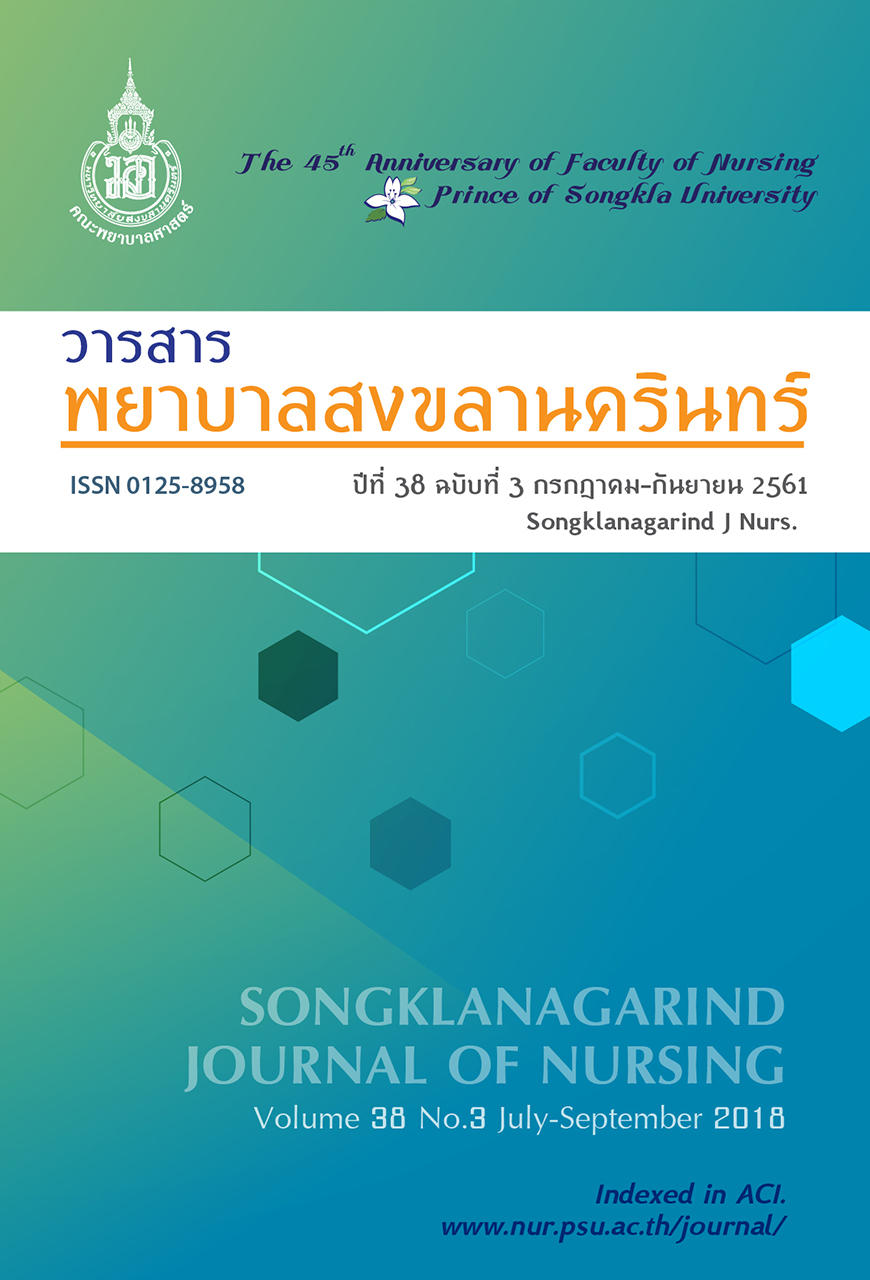Nursing Students’ Experiences of Using the 5A’s Model for Tobacco Control Among Adult and Elderly Patients
Main Article Content
Abstract
This study aimed to explore nursing students’ experiences of using the 5A’s model for tobacco
control among adult and elderly patients. This study is a qualitative research using the structured interview
for data collection. Key informants were 33 of the third year nursing students at the Faculty of Nursing,
Prince of Songkla University. Data were collected between October 2017 and December 2017. Data were
analyzed using content analysis.
The results showed that four major themes emerged from the data analysis; 1) having good attitudes
on the use of the 5A’s model, 2) the 5A’s model is feasible to be used in nursing practice, 3) the 5A’s
model is consistency with the nursing process, and 4) perceived barriers to its use of 5A’s model. The
findings could be used as a basis to improve learning process in order to integrate the tobacco control in
nursing. In addition, the findings could be used to improve nursing students’ knowledge, understanding, and
skills regarding the use of 5A’s model, and in turn to improve outcomes of care for patients, family, society,
and environment.
Article Details
References
2. World Health Organization. Tobacco Fact Sheet [cited 2018 Mar 9]. Available from: http://www. who.int/mediacentre/factsheets/fs339/en/
3. National Statistical office. Statistical forecasting bureau national statistical office: The smoking and drinking behavior survey 2014 [cited 2018 June 9]. Available from: http://service.nso.go.th/nso/nsopublish/themes/files/smokeFullReport 57-1.pdf.Thai
4. Centers for disease control and prevention. Differences by sex in tobacco use and awareness of tobacco marketing-bangladesh, Thailand, and Uruguay, 2009 weekly May 28, 2010/ 59(20); 613-18. Available from: https://www.cdc.gov/mmwr/preview/mmwrhtml/mm5920a2.htm
5. Nurse network on tobacco control of Thailand. Vision and Mission [cited 2017 Dec 15]. Available from: http://tobaccofree.thainurse.org/index.php? option=com_content&view= article&id=3&Itemid=137&lang=th. Thai.
6. Tobacco TC. A clinical practice guideline for treating tobacco use and dependence: 2008 update: A U.S. Public Health Service report. Am J Prev Med. 2008;35(2):158-76. doi:10.1016/j.amepre.2008.04.009.
7. Kotarputh R, Kumsiriruk N, Imnamkhao W, et al. The Results of integration of teaching tobacco control course and family and community nursing practicum II course for the Fourth-Year nursing students at srimahasarakham Nursing College. Journal of Nursing and Education.2011;4(2):53-63. Thai.
8. Panpakdee O, Siriphittayakhunkji A, Likitluecha N, et al. A Survey of nursing practice on smoking cessation service in Thailand. Thai Journal of Nursing. 2017;66(1),1-8. Thai.
9. Harrison MB, Légaré F, Graham ID, et al. Adapting clinical practice guidelines to local context and assessing barriers to their use. CMAJ. 2010;182(2):78-84. doi: 10.1503/cmaj.081232. Epub 2009 Dec 7.
10. Hsieh HF, Shannon SE. Qual Health Res. 2005;15(9): 1277-88. doi:10.1177/1049732305276687
11. Centers for Disease Control and Prevention (CDC). State-specific trends in lung cancer incidence and smoking-United States, 1999-2008. MMWR Morb Mortal Wkly Rep. 2011;60(36):1243-7
12. Schlyter M, Leosdottir M, Engström G, et al. Smoking cessation after acute myocardial infarction in relation to depression and personality factors. Int J Behav Med. 2016;23(2):234-42. doi: 10.1007/s12529-015-9514-y.
13. Slev VN, Pasman HR, Eeltink CM, et al. Self-management support and eHealth for patients and informal caregivers confronted with advanced cancer: An online focus group study among nurses. BMC palliative care. 2017; 16(1): 55. doi: org/10.1186/s12904-017-0238-4
14. Sonmez CI, Aydin LY, Turker Y, et al. Com-parison of smoking habits, knowledge, attitudes and tobacco control interventions between primary care physicians and nurses. Tob Induc Dis. 2015;13(1):37. doi: 10.1186/s12971-015-0062-7
15. Chalmers K, Seguire M, Brown J. Health pro-motion and tobacco control: Student nurses’ perspectives. J Nurs Educ. 2003;42(3):106-12.
16. Butler KM, Rayens MK, Zhang M, et al. Tobacco dependence treatment education for baccalaureate nursing students. J Nurs Educ. 2009;48(5): 249-54 doi.org/10.3928/01484834-20090416-03
17. Sheffer CE, Barone C, Anders ME. Training nurses in the treatment of tobacco use and dependence: pre-and post-training results. J Adv Nurs. 2011; 67(1): 176-83. doi: 10.1111/j.1365-2648.2010.05483.x


